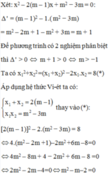Hãy nhập câu hỏi của bạn vào đây, nếu là tài khoản VIP, bạn sẽ được ưu tiên trả lời.

\(x^2-\left(m+4\right)x+4m=0\) (1)
a)Thay x=2 vào pt (1) ta được: \(4-\left(m+4\right).2+4m=0\) \(\Leftrightarrow m=2\)
Thay m=2 vào pt (1) ta được: \(x^2-6x+8=0\)\(\Leftrightarrow x^2-4x-2x+8=0\)
\(\Leftrightarrow\left(x-4\right)\left(x-2\right)=0\)\(\Leftrightarrow\left[{}\begin{matrix}x=2\\x=4\end{matrix}\right.\)
Vậy nghiệm còn lại là 4
b)Để pt có hai nghiệm pb \(\Leftrightarrow\Delta>0\Leftrightarrow m^2-8m+16>0\)\(\Leftrightarrow\left(m-4\right)^2>0\)\(\Leftrightarrow m\ne4\)
Do x1 là một nghiệm của pt \(\Rightarrow x_1^2-\left(m+4\right)x_1+4m=0\)
\(\Rightarrow x_1^2=\left(m+4\right)x_1-4m=0\)
Theo viet có: \(x_1+x_2=m+4\)
\(x_1^2+\left(m+4\right)x_2=16\)
\(\Leftrightarrow\left(m+4\right)x_1-4m+\left(m+4\right)x_2=16\)
\(\Leftrightarrow\left(m+4\right)\left(x_1+x_2\right)-4m-16=0\)
\(\Leftrightarrow\left(m+4\right)^2-4m-16=0\)
\(\Leftrightarrow m^2+4m=0\)
\(\Leftrightarrow\left[{}\begin{matrix}m=0\\m=-4\end{matrix}\right.\)(Thỏa)
Vậy...

a) Ta có: \(\Delta=\left(-4\right)^2-4\cdot1\cdot\left(2m-3\right)=16-4\left(2m-3\right)\)
\(\Leftrightarrow\Delta=16-8m+12=-8m+28\)
Để phương trình có hai nghiệm x1;x2 phân biệt thì \(-8m+28>0\)
\(\Leftrightarrow-8m>-28\)
hay \(m< \dfrac{7}{2}\)
Với \(m< \dfrac{7}{2}\) thì phương trình có hai nghiệm phân biệt x1;x2
nên Áp dụng hệ thức Viet, ta có:
\(\left\{{}\begin{matrix}x_1+x_2=\dfrac{-\left(-4\right)}{1}=4\\x_1\cdot x_2=\dfrac{2m-3}{1}=2m-3\end{matrix}\right.\)
Để phương trình có hai nghiệm x1,x2 phân biệt thỏa mãn tổng 2 nghiệm và tích hai nghiệm là hai số đối nhau thì
\(\left\{{}\begin{matrix}m< \dfrac{7}{2}\\4+2m-3=0\end{matrix}\right.\Leftrightarrow\left\{{}\begin{matrix}m< \dfrac{7}{2}\\2m+1=0\end{matrix}\right.\)
\(\Leftrightarrow\left\{{}\begin{matrix}m< \dfrac{7}{2}\\2m=-1\end{matrix}\right.\Leftrightarrow\left\{{}\begin{matrix}m< \dfrac{7}{2}\\m=-\dfrac{1}{2}\end{matrix}\right.\Leftrightarrow m=-\dfrac{1}{2}\)
Vậy: Khi \(m=-\dfrac{1}{2}\) thì phương trình có hai nghiệm x1,x2 phân biệt thỏa mãn tổng 2 nghiệm và tích hai nghiệm là hai số đối nhau

a) \(\Delta=\left[-\left(m+3\right)\right]^2-4.1.m\\ =m^2+6m+9-4m\\ =m^2+2m+9\\ =\left(m+1\right)^2+8>0\forall m\)
Vậy phương trình luôn có 2 nghiệm phân biệt với mọi m.
b) Áp dụng hệ thức Vi-et, ta có:
\(\left\{{}\begin{matrix}x_1+x_2=m+3\\x_1x_2=m\end{matrix}\right.\)
Mà \(x_1^2+x_2^2=6\)
\(\Leftrightarrow\left(x_1+x_2\right)^2-2x_1x_2=6\\ \Leftrightarrow\left(m+3\right)^2-2m=6\\ \Leftrightarrow m^2+6m+9-2m=6\\ \Leftrightarrow m^2+4m+3=0\\ \Leftrightarrow\left(m+1\right)\left(m+3\right)=0\\ \Leftrightarrow\left[{}\begin{matrix}m=-1\\m=-3\end{matrix}\right.\)
Vậy \(m\in\left\{-1;-3\right\}\) là các giá trị cần tìm.
a, Ta có: \(\Delta=\left[-\left(m+3\right)\right]^2-4.1.m\)
\(=m^2+6m+9-4m\)
\(=m^2+2m+9\)
\(=m^2+2m+1+8\)
\(=\left(m+1\right)^2+8\)
Lại có: \(\left(m+1\right)^2\ge0\forall m\Rightarrow\left(m+1\right)^2+8\ge8\forall m\)
Vậy phương trình luôn có 2 nghiêm phân biệt
b, Theo hệ thức Vi-ét: \(\left\{{}\begin{matrix}x_1+x_2=m+3\\x_1+x_2=m\end{matrix}\right.\)
Theo bài ra:
\(x_1^2+x_2^2=6\)
\(\Leftrightarrow\left(x_1+x_2\right)^2-2x_1x_2=6\)
\(\Leftrightarrow\left(m+3\right)^2-2m=6\)
\(\Leftrightarrow m^2+6m+9-2m=6\)
\(\Leftrightarrow m^2+6m+9-2m-6=0\)
\(\Leftrightarrow m^2+4m+3=0\)
\(\Leftrightarrow m^2+m+3m+3=0\)
\(\Leftrightarrow\left(m^2+m\right)+\left(3m+3\right)=0\)
\(\Leftrightarrow m\left(m+1\right)+3\left(m+1\right)=0\)
\(\Leftrightarrow\left(m+1\right)\left(m+3\right)=0\)
\(\Leftrightarrow\left[{}\begin{matrix}m+1=0\\m+3=0\end{matrix}\right.\)
\(\Leftrightarrow\left[{}\begin{matrix}m=-1\\m=-3\end{matrix}\right.\)
Vậy với m=-1 hoặc m=-3 thì phương trinh trên thỏa mãn hệ thức

a)thay m=1 vào pt ta có
\(x^2+4x=0\)
<=> \(\left[{}\begin{matrix}x=0\\x=-4\end{matrix}\right.\)
b) thay x=2 vào pt ta có: 13+m=0
<=>m=-13
thay m=-13 vào pt ta có
\(x^2+4x-12=0\)
<=>(x-2)(x+6)=0
<=>\(\left[{}\begin{matrix}x=2\\x=-6\end{matrix}\right.\)\(\)
vậy với m=-13 thì nghiệm còn lại là x=-6
c) để pt có 2 nghiệm pb thì \(\Delta>0\)
<=>16-4m-4>0
<=>3-m>0
<=>m<3
áp dụng định lí Vi-ét ta có\(\left\{{}\begin{matrix}x_1+x_2=-4\\x_1x_2=m+1\end{matrix}\right.\)
theo đề bài ta có \(x_1^2+x_2^2=10\)
<=>\(\left(x_1+x_2\right)^2-2x_1x_2=10\)
<=>16-2m-2=10
<=>2-m=0
<=>m=2(nhận)
vậy với m=2 thì pt có 2 nghiệm pb thỏa yêu cầu đề bài.

\(\Delta=\left(m+1\right)^2-4.1.2=\left(m+1\right)^2-8\)
Để PT có 2 nghiệm thì:
\(\Delta\ge0\Leftrightarrow\left(m+1\right)^2-8\ge0\\ \Leftrightarrow\left(m+1\right)^2\ge8\)
Theo vi ét: \(\left\{{}\begin{matrix}x_1+x_2=-\left(m+1\right)\\x_1x_2=2\end{matrix}\right.\)
\(x_1^2+x_2^2=x_1^2+2x_1x_2+x_2^2-2x_1x_2=\left(x_1+x_2\right)^2-2x_1x_2\)
\(=\left(m+1\right)^2-2.2=\left(m+1\right)^2-4\)
Mà \(\left(m+1\right)^2\ge8\) nên \(\left(m+1\right)^2-4\ge4\)
\(\Rightarrow min_{x_1^2+x_2^2}=4\) (dấu bằng xảy ra)
\(\Leftrightarrow\left(m+1\right)^2=8\)
\(\Leftrightarrow m^2+2m+1=8\\\Leftrightarrow m^2+2m-7=0 \)
\(\Leftrightarrow m=-1\pm2\sqrt{2}\)

a) \(x^2-mx+2m-4=0\) nhận \(x=3\) là nghiệm nên:
\(3^2-m.3+2m-4=0\)
\(\Leftrightarrow9-3m+2m-4=0\)
\(\Leftrightarrow m-5=0\)
\(\Leftrightarrow m=5\)
Vậy phương trình trở thành: \(x^2-5x+6=0\) nhận x=3 là nghiệm vậy nghiệm còn lại là:
\(\Delta=\left(-5\right)^2-4.1.6=1\)
\(\Rightarrow\left\{{}\begin{matrix}x_1=\dfrac{-b+\sqrt{\Delta}}{2a}=\dfrac{-\left(-5\right)+\sqrt{1}}{2.1}=3\\x_2=\dfrac{-b-\sqrt{\Delta}}{2a}=\dfrac{-\left(-5\right)-\sqrt{1}}{2.1}=2\end{matrix}\right.\)
Vậy nghiệm còn lại là \(x=2\)

a: Khi m=2 thì pt sẽ là \(x^2-8x-9=0\)
=>x=9 hoặc x=-1
b: \(\text{Δ}=\left(2m+4\right)^2-4\left(-2m-5\right)\)
\(=4m^2+16m+16+8m+20=4m^2+24m+36\)
\(=4\left(m^2+6m+9\right)=4\left(m+3\right)^2>=0\)
Để phương trình có hai nghiệm phân biệt thì m+3<>0
hay m<>-3
Theo đề, ta có: \(\sqrt{\left(x_1+x_2\right)^2-4x_1x_2}=2\)
\(\Leftrightarrow\sqrt{\left(2m+4\right)^2-4\left(-2m-5\right)}=2\)
\(\Leftrightarrow\sqrt{4m^2+16m+16+8m+20}=2\)
\(\Leftrightarrow4m^2+24m+36=4\)
\(\Leftrightarrow m^2+6m+9=1\)
=>m+3=1 hoặc m+3=-1
=>m=-2 hoặc m=-4

